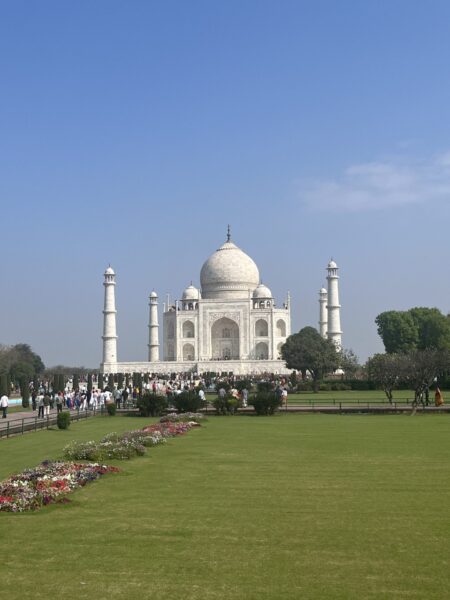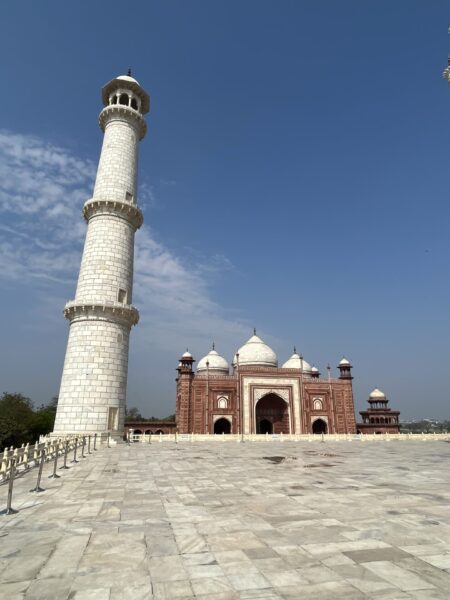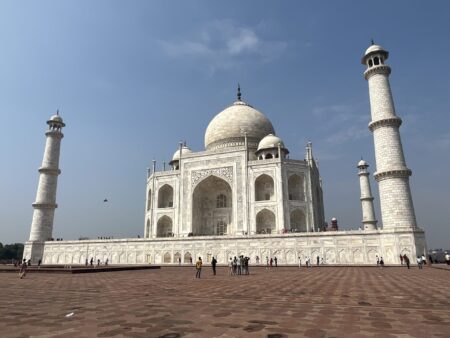The Taj Mahal shouldn’t need any introduction. The iconic mausoleum is instantly recognizable, the most visited site in India, and one of the most photographed edifices in the world. And yet, I feel like not enough words can be used to describe it.
I always dismissed it somehow. Always thinking that yes, it was splendid and a must-see “wonder of the world”. However, it is also constantly riddled with crowds, like ants swarming around a nest. It is, after all, a major tourist attraction and the most visited site in India, with 8 million people visiting every year (the majority of whom are Indians and not foreigners). It is always the same. It doesn’t have a “lifecycle” during the day like other places I already talked about, like Petra and Tikal, which radically change if you beat the crowds and explore it “untouched” when the animals still roam around before sunrise. It just sits there.
When I visited it, I saw that this was true. But also, this is its incredible charm. This ivory mausoleum just sits there, still and sorrowful, in front of the Yamura riverbank.
Like many places, I knew that the photos didn’t do it justice. Most, if not all of them, are the same: with the reflection pool in front, crowds everywhere, and a person at the center of the frame being the subject of the photo with the Taj in the background. Instead, the Taj commands total attention. But it does so with a whisper. From the moment one traverses the gate and the sight opens to them, with it revealing itself in its majestic glory, one cannot take their eyes away from it.
Through the waves of visitor crowds, group pictures, selfie sticks, and everyone gathering by the reflection pool, the Taj remains there in the distance, silent and elegant. The more you approach it, the larger and more imposing it becomes, leaving the side gates, mosques, and gardens out of sight until all that you can see is the white marble reflecting the sunlight. And yet, from whichever angle or distance you look at it, the Taj never loses its grace. It remains elegant. Most notably, it remains quiet.
This is because it is known as a monument of love, a monument to love, and it is one of the few places in the world where I felt something visibly exuding this aspect.
The Mughal emperor Shah Jahan ordered the construction of this mausoleum for his most beloved wife, Mumtaz Mahal. She rests here, as does he. There are legends of the “Black Taj Mahal,” which was supposed to be placed on the opposite end of the river to host the remains of the emperor, but it was never built. Perhaps it was only a legend, but in any case, his successor, Aurangzeb, didn’t have the inclination for these lavish constructions and concentrated efforts elsewhere. into expansion and into the empire.
And this is what we usually see when visiting ancient archaeological sites or grand palaces: manifestations of the power and reach of an empire. They are grand, awe-inspiring, and powerful. But seldom do you see monuments of sorrow. Or delicate beauty.
Sure, the Taj took 20 years to build, and it is said that the city of Agra and the region were struck by intense famine because of it. As is often the case, these incredible temples, tombs, altars, and palaces are simply the whims of the ruler of the region at that time, often interested only in leaving a perpetual mark in the history of their passing. The Taj is no different from this, except Shah Jahan built it for his wife. There is no other mausoleum or palace in Mughal history as beautiful as the Taj, and, personally, thinking that all this energy was spent—20 years of construction—to create the tomb for a beloved lost one remains, yes, an act that only a somewhat detached emperor would do, but an act that evokes empathy.
So the Taj Mahal is a must-do on any traveler’s or tourist’s bucket list. But after you have traversed the gate and seen its grandeur, take a detour on the side paths, walking through the silent, lush green gardens. Or sit for a while at its sides, on the steps of the red mosque, or behind it, watching the river flow. Looking at the Taj will instill peace and tranquility, and you will feel a sense of mourning.
Seeing the Taj is therefore not only a wonder of the world. It is not only seeing firsthand one of the most recognizable and photographed buildings on Earth. It is not only a prime, if not the best, example of the architecture of the Mughal empire. It is like seeing a stack of cold white rocks that comes to life and talks back to you in a quiet and gentle tone. Standing sad but serene on the riverbank, surrounded by tranquil gardens and flowing water, it is like an old man looking at the sunset. Silent, still, and etched into history.
I think no words better describe it than those of the Indian poet Rabindranath Tagore when he said that the Taj Mahal is “a teardrop on the cheek of eternity”.
The following guide will help you plan your visit so that you can make the most of the “Crown of the Palaces”.
Basic info
The Taj Mahal is located in the city of Agra, in the state of Uttar Pradesh. It is open all year round except on Fridays, which is Al-Jumah – the day of congregation in the Islamic religion. Opening hours are from 6 AM to 6:30 PM with 3 major waves of visitors (those interested in watching the sunrise, those who visit in the late morning and those who visit in the late afternoon and stay for sunset).
About
Taj Mahal means “Crown of the Palaces” and was commissioned by the Mughal emperor Shah Jahan in 1631 as a mausoleum for his “favorite” wife Mumtaz Mahal. Designed by the architect Ustad Ahmad Lahori, it took over twenty years to construct. It is a 73-meter-tall structure placed within a 42-acre site and built of white marble (in contrast to many other edifices of the time that were made of red sandstone) in Mughal architectural style. The Taj receives up to 8 million visitors annually, with most of the visitors from India itself. It is the most visited landmark in the country, and the crowds can easily get overwhelming.
The Site
The site is relatively contained. As with much of Mughal architecture, the main “attraction” is hidden away behind a surrounding wall and can be accessed only from a main gate (darwaza). The gate opens onto the garden and the main walkway with the reflecting pool, leading straight to the mausoleum with two additional side paths coasting through the gardens. On the two sides of the mausoleum are two identical red stone buildings that face each other, with one being a mosque. Inside the mausoleum, photos are not permitted, and there is a looping circle around the tomb. Of note are its incredible acoustics and the intricate carvings of the window screens (jali), which deform the incoming sun rays. Not a lot of time is required to visit the monument. Most people recommend 3 hours to explore all the beautiful locations, and the entrance tickets themselves have a duration of 3 hours (not that anybody checks once you get inside).
Best time to visit
If you are looking to take the standard, highly sought-after photo that everybody wants in front of the Taj by yourself, you will have to get up early in the morning at 5 and be there by 6 at sunrise when the site opens. The best days to plan a visit are between Monday and Thursday, which have slightly fewer crowds, but if you really want the site to yourself, the only option is to go at sunrise. As stated initially on Friday, the site is closed, but the Taj Mahal can still be admired from Mehtab Bagh. These are the “moonlight gardens,” which stand on the opposite side of the Yamuna River and were built explicitly with the intent to provide the best possible viewing spot of the mausoleum for the emperor Shah Jahan. There are also light shows in the evening. I did not see them myself, so I cannot judge, but apparently, they are not worth it as visitors need to remain at a distance and the lights scatter on the structure, making it hard to see.
Entrances & Getting around
There are three entrances to the complex: the west, east, and south gates. Once inside the large plaza, the only route is through the inner gate, which is a small octagonal entrance hall that opens up to the Mughal gardens. Cars are allowed up to 1km from the entrance; from then on, it’s either walking or hiring one of the rickshaws or carts. Many monuments in India have strict “airport-style” screening processes at the entrance. The Taj is no different, and more so. Any tobacco products cannot be brought inside, as well as drones, and large electronic devices cannot be brought inside the site. I always carry my laptop with me wherever I go, so I had to hand it in. The funny thing is that, although there are lockers, security will try to help the local vendors and will probably divert you to one of the many shops or food places in front of the entrance. There, the process of handing in your valuables is worrying, to say the least, and you just give your items to the vendor who places them under the desk and leave, hoping they will remember you and still have the items when you come back and return them to you. Just from my anecdotal experience, I gave 100 rupees to hold my cigarettes, lighter, and laptop and did not have any problems retrieving them. I was not “harassed” too much by the vendor trying to sell his items when I went to retrieve my things. In general, many recommendations say to simply not carry anything, as the security checks are quite aleatory and they will confiscate or throw away anything that pleases them (such as toys or batteries).
Other tips
- Don’t use the toilets, as they are filthy without any “amenities”, such as toilet paper, and require payment. Understandable given the sheer amount of visitors the Taj receives each day.
- The main central path leading to the mausoleum is where everyone walks, and you will do too, but take the side paths to enjoy the gardens and tranquil walk.
- A few hundred meters before the west entrance is the Taj Nature Walk, a long, winding walk within a park. There are several spots that allow you to get glimpses of the Taj in the distance. Also, if you venture deep into the park, you can exit from an “illegal” (aka broken gate), which leads to a cemetery and a small settlement that stands right beside the Taj. Near this area is what is known as the “Secret Taj viewpoint” (not so secret as it is shown on Google Maps)
Clothing/Gear
Since the site is relatively contained, one does not need any particular preparation in terms of walking shoes, water bottles, etc. Being a mausoleum and with the presence of a mosque, clothing should be modest and cover arms and knees. Also, given the strict security screening, the allowed photographic equipment is minimal (i.e., no drones; large video recording equipment can be brought only to a certain point and requires a hefty fee).
Weather
Regarding seasons, avoid winters (i.e., from the months of November to February), as the Taj will be shadowed by fog. Early (so from March to June) is the best time to visit the monument.












